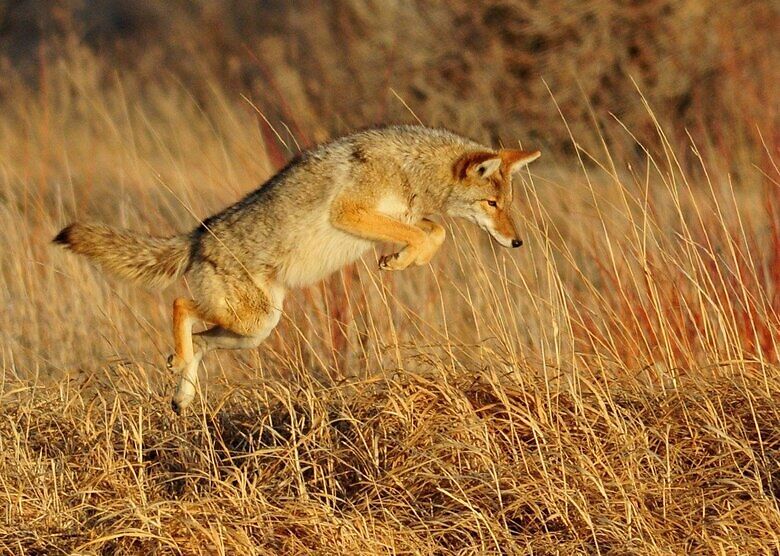Different Ways to Get Rid of Coyotes
Coyotes are nuisance predators that can wreak havoc on farm animals, livestock, domestic pets, landscaping, and even infrastructure like irrigation pipes. These animals are extremely widespread in the United States and are quick to adapt to nearly any environment. In the years since the decline of most US wolf populations, coyotes have taken over wolf territories and now spread from coast to coast. They can even be found in the largest American cities like Chicago and New York.
Coyotes are mainly carnivores with a diet consisting of about 90% meat. They will not hesitate to attack defenseless animals that present an easy meal. For this reason, it’s critical that you take preventative measures to protect your livestock and pets.

About Prevention
Coyote prevention methods are non-lethal tactics that try to discourage these animals from entering your property. Non-lethal methods are the best defense against coyotes for several reasons.
- they are much more cost-effective
- they seek to prevent animal losses from ever occurring
- they are humane for all animals
- they preserve the natural ecosystem of your area by ensuring that the predator/prey balance remains stable
There are quite a few non-lethal coyote prevention methods you can try right now with very little equipment or expense. The prevention methods listed below can provide long-lasting protection with very little investment on your part.
Fencing
Installing a fence is typically the first line of defense against any nuisance animals, and it’s reasonably effective. The main problem with coyote fencing is that coyotes are able to jump extremely high for their size and can also dig underneath fences.
You might be thinking that fencing isn’t really a cost-effective method, but there are cheaper styles available which still do the job well.
A woven wire fence is the best choice for coyote prevention.
To effectively keep coyotes out, the fence must be at least six feet tall and have gaps between wires that are no larger than six inches. It must also extend downward into the ground by at least one foot.
Electric fences are another good option that allows you to keep the fence height slightly lower. Unfortunately, these fences can be expensive and do not protect against predators that dig underneath fences. That said, placing a live wire very near the ground can be an effective strategy against digging animals.
Fladry
Fladry is a simple concept with a significant effect on coyotes.
- Fladry is a rope with a large number of narrow red flags hanging from it at regular intervals.
These simple devices are very effective at deterring both wolves and coyotes.
Another variation of fladry is turbo fladry, where a live electric wire is added to the setup. This is even more effective against coyotes.
Sheep Dogs & Guardian Animals
Livestock guardian animals are proven to significantly lower the risk of livestock loss from predators. Guardian animals are typically dogs that are raised specifically for this purpose, although some ranchers use llamas or donkeys as guardian animals. This method does take some work on the part of the farmer – you should make sure your guardian animals are closely bonded with your livestock before leaving them alone together.
Corrals
Constructing sturdy corrals for your animals is essential for their safety. You should always corral your animals at night if possible, as this is when coyotes are most likely to attack. You can increase the safety of your animals by making sure their corrals are well lit and clear of brush and other debris.
Removal Methods
If prevention doesn’t seem to work, then there are some removal methods you may want to try.
Live Trapping
The most effective and most humane removal method is live trapping. Trapping coyotes isn’t as simple as you might think – these wily creatures are tricksters and are known to evade traps, so you need to hire an expert or learn some professional techniques if you want to try it yourself.
Trapping is the best non-lethal coyote removal method because when it works, the animal is removed without any drawbacks.
DON’T KILL
The problem with lethal methods like poison or kill traps is that they rarely target the animal you actually want to kill. There can be a lot of innocent animal losses with these methods.
On top of that, there’s a large body of scientific research that shows that killing predators widely and at random will actually increase the risks towards livestock. It might seem counterintuitive, but indiscriminate killing damages the social and foraging ecology of species like coyotes. This can increase the number of solitary animals, which increases the risk of livestock.
Even more, research shows that killing large numbers of coyotes actually causes them to breed faster and more frequently, resulting in more predators than you ever had. The “solution” of killing can actually result in more predators down the line. Killing will never remove every predator, so it must be done constantly to be even remotely effective.
